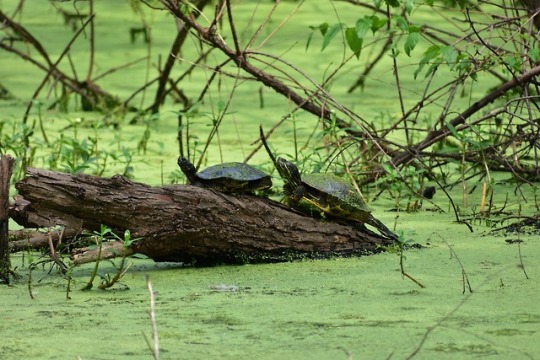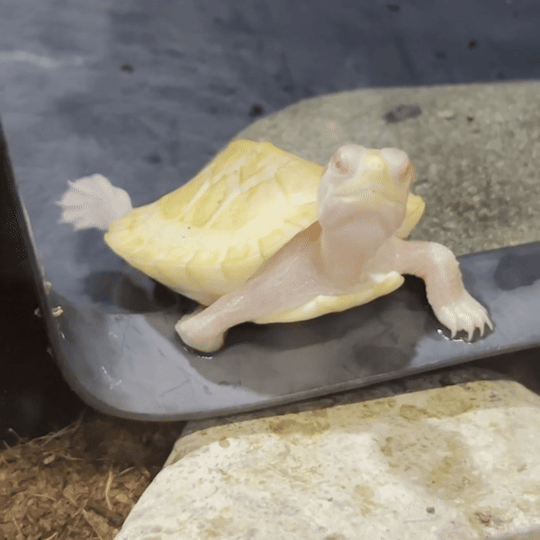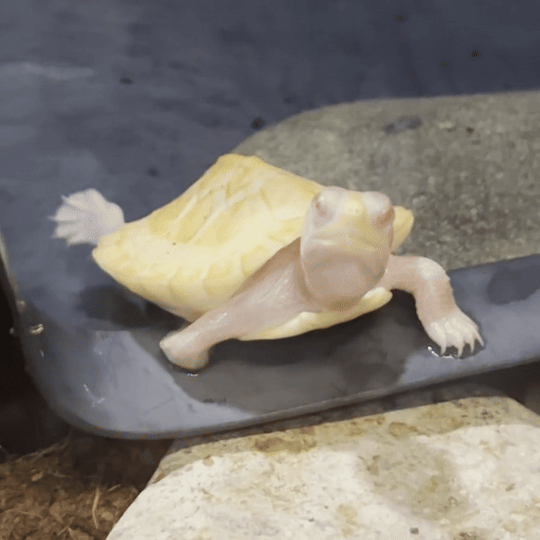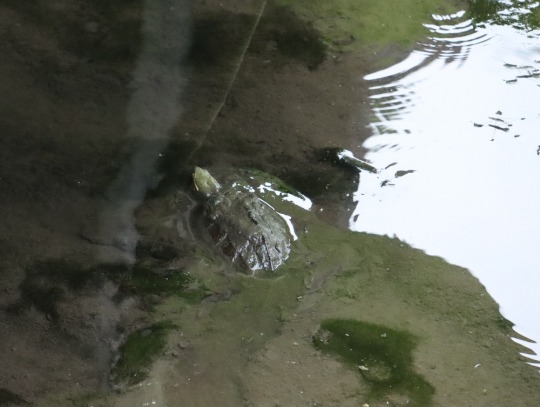#Trachemys scripta
Explore tagged Tumblr posts
Note
Do you know any cool fact about turtles you want to share with the class? /genuine
WHEN I SAY THIS I MEAN IT BUT LITERALLY RUNNING IN CIRCLES RN YES FINALLY!!!!!!!!
Ejem.
I'll start with the basics then expanding but also winging it because yes. Under read more because I infodumped hard here
So sliders. Sliders (trachemys) is a genus that lives all of america, and which it's main and most known subspecies, red eared sliders (RES, or scripta elegants) is best know by two things: the fact that it's the most popular type of pet turtle globaly, and that they are STUPIDLY resilient. These two facts, naturally, create the perfect storm for an extremely invasive species due to neglectful or ignorant owners who get tired of the eety beety lil bean once it starts to show it grows to a max size of 12 inches/30cms and lives to even 30 years old.
However, I still think that, in the correct hands, they are a wonderful pet for experimente or mindful owners (what I cathegoryze as mindful is whoever knows ot is open to provide the correct space a goldfish should live in, since it's the same for turtles and plottwist; none of them both is fishbowl or less that 10 gallons option) so some info on them:
When they are tiny, their yolksack cord and egg teeth is visible, and it's so cute because it's this tiny thingy the size of a coin omg 🥺. At this age they are known as hatchlings, and they have certain qualities that only stay on this age;
-color: they are a shiny, beautiful emerald color, with orang-y ears and Grey-blue-ish eyes. As they age, they turn brown while they are juveniles and finally end up black/deep forest green/dark yellowing brown (depends on the specimen)
-diet: when babies, they are mainly carnivores, eating fish, bugs and whatever they can scavange, with plants here and there, but as they age they eat more and more greens, until their diet is around 80% these. In captivity the recommended in protein is crickets, roaches, mealworm, blood worms and feeding fishes, like goopies. On the greener side the recommended is red and green leaf lettuce (avoid iceberg at all coast and only sometimes Roman and buttercup), dandelion leaves and turnip greens, with sometimes endives, kale and escarole. They also like aquatic plants like Amazonian sword, duck weed, moss balls, water lettuces and frogbit, to name some. Some veggies like carrot, bell pepper, sparce fruits like bananas, apples, mango, melon, strawberries, blueberries, papaya and raspberries are also good for em. On store brand pellets zoomed and mazuri are the standard.
But enough about that. One common asked question; how to know their sex? As most reptiles, turtle sex is determined based on the temp the eggs are incubated. There is this myth about how the markings show the sex, but this is a lie, as the markings change depending on the species and subspecies. There is also said that males have a concave plastron and females have a flat one, since it facilitates reproduction. And while it is true, the best way to tell is waiting for em to hit puberty. Once they are 4 inches/10cms long OR one-two years old OR have a black shell, the males start to develop longer claws, which can get to an inch/3cms long. This, plus the cloaca placement/tail size is your best bet, as it is really distinctive and easy to tell male claws from females. Females are also easier to diferenciate due the fact that, once they grow to their whole size, females are the biggest, while males stay at around 25cms or something like that. Tiny guys.
However, I personally knew in mine's case due the fact he showed me his turtle penis while he threw a temper tantrum over me picking him up.
In the reproduction topic. As I've mentioned in another post, they have an apareament dance, known as jazz hands. It's pretty self descriting, as they put their hands next to their face and vibrate them at super speed. This behavior also occurs between territorial fights. Once they got their things settled, the male chases the female and they do the thing. In this, those longer claws we talked about help them stay in place while copulating.
And in that territoriallity note, they are extremely territorial and solitary animals. They need AT LEAST 10 gallos per inch of shell, and can't cohabitate unless they are in like, a pond. However, even then they could become hostile. The hostility signs are mainly stacking (they get one in top the other while basking, they do this to compete for space and UVB/heat from the sun) fighting over food (in captivity, if kept together, sometimes one baby grows faster than the other, this is due that) chasing eachother and actual fighting (biting, scratching, it can go from easily-infectable lacerations to fights-to-death). Due to this and more reasons, unless for breeding and when knowing exactly what you are doing, it is extremely important to NOT cohabitate under any circunstance.
I think I'm leaving it at there for today, might add more in a rb tomorrow, but it's literally midnight and I should sleep lol. Thank you so much for asking! I love so much to talk about these goobers and you made my day (night?) I also wanna mention that I'm constantly learning and that, if any of this info is wrong or outdated, please let me know! With that said, goodnight!
#Turtle#turtles#red eared slider#Reptiles#herpetology#Infodump#Autism talking hours#Infodumping#Sliders turtle#Trachemys#Trachemys scripta#Scripta elegans#saf orate hour
3 notes
·
View notes
Photo

I may very well have already posted this.
#red-eared slider#red-eared terrapin#conservation status: least concern#Animalia#Chordata#Reptilia#Testudines#Cryptodira#Emydidae#Trachemys#Trachemys scripta#Trachemys scripta elegans#turtles#pond turtles#marsh turtles#subspecies#Nikon D3400#nikonphotography#my reptiles#nature photography#photographers on tumblr#Black Bayou Lake National Wildlife Refuge#feral animals#invasive reptile species#turtles of Europe#reptiles of North America#reptiles of the United States#wildlife
15 notes
·
View notes
Text
UPDATE TIIIME!
I took the live specimens and preserved leeches into my lab to take a closer look! This was not a formal lab and nothing was documented or peer reviewed, these are personal observations that I thought were Neato (trademark).
I'll be covering my observations on the preserved leeches in this post. I know this can make people squeamish, so I'll put pictures and info under the cut!
Live Placobdella parasitica specimens
These critters were in my care for three days, and I observed some of their behaviors in a controlled environment.
Containment: 1/2 gallon (1.9L) plastic fish tank, 75% filled. Water was ~2:8 locally collected pond water and filtered/dechlorinated tap water. No additional enrichment, live organisms, or substrate was added.
Leeches exhibited normal leech behaviors: dormancy when exposed to light and more activity when tank was covered in a towel (typical nocturnal behavior). All locomotion observed was peristaltic (typical of annelids). The most interesting behavior I got the chance to observe was a wave-like "flag-in-the-wind" motion to increase oxygen uptake, since leeches respire through the body wall.
youtube
When water was disturbed, leeches exhibited "agitated" activity (more movement in general, flailing superior). Poor attachment to glass while transferring caused the two specimens to attempt to suction onto eachother using both anterior and posterior suction cups.
Now for the micro stuff! Because I did not use a lot of pond water, there were unfortunately not many live microorganisms. I found a handful of ciliated protozoan species and some unidentifiable organisms in the mix (I'm not a micro student and they were moving too fast, bear with me).
youtube
youtube
My suspicions about larval Placobdella parasitica were NOT confirmed. The white string-like growths on the mature specimens are unidentifiable to me, maybe someone with more expertise would like to chip in? This does not look like a larval/juvenile leech, but the two "tails" on what I assume is the posterior are not present in any planarians I can find. All specimens of the unknown sp. had these "tails."


Below are pictures of preserved and partially dissected leeches as well as blood samples, please be cautioned if you are squeamish.
This is my first time delving into any micro lab unsupervised, and I am EXTREMELY amateurish when it comes to microscopy. I am open to any advice!
Attempting to pin and dissect subadult Placobdella parasitica was a nightmare, as they were ~8mm and I did not have the proper tools; however, being able to see their innards was pretty neat (unlabeled because I genuinely have no idea, organism was too dried out).


I extracted some blood from a recently fed subadult Placobdella parasitica to take a look at and results were also a little rough. I don't know if it's due to the isopropyl alcohol I used to preserve, blood mixing from the leech/turtle, or coagulation and desecration of blood from the gut of the leech. It's likely all three. After talking to my biology professor (who has a PhD in viral biology), we discovered that turtles have nucleated blood - in fact, all non-mammilians do! I drew my own blood for the sake of comparison, and after posting the comparisons in a Discord I'm in, one of my friends who has been doing blood samples for years kindly informed me that my samples were too thick and causing coin stacking. I do not have any blood diseases. Any coagulation is because I drew this blood from a recently-scabbed spider bite.


I hope this little deep dive was interesting! As promised, the live leeches got released. A great egret Ardea alba nearby was vocalizing while I was at the creek, probably to let me know that she could see me.



Prettiest leeches I've ever seen!
These are local Placobdella parasitica (smooth turtle leeches) I pulled off of our permanent-rehab pond sliders. While these critters can evade detection on healthy aquatic turtles by staying under the shell and behind the legs, they're given an advantage over turtles with deformed/injured shells and turtles with less leg functionality, (assumedly) allowing them to multiply over more surface area.
I will be taking these two (live) specimens to my bio lab on Tuesday. I removed a large cluster of juveniles that I have since humanely euthanized from a large pond slider to bring in as well. The two live specimens are mature adults and will be released after lab examination.
Unfortunately, there is not much in terms of information on these guys. Hopefully we see more about them in the future!





#deep fried info bites#animals#animal#animal rescue#gulf coast#gulf coast wildlife#wildlife#leeches#tw leech#leech#tw blood#cw blood#microscope#microscopy#biology#ecology#placobdella parasitica#trachemys scripta#ardea alba#Youtube
217 notes
·
View notes
Text
𝐔𝐧𝐚 𝐜𝐨𝐧𝐭𝐫𝐨 𝐭𝐮𝐭𝐭𝐞: 𝐥𝐚 𝐥𝐨𝐭𝐭𝐚 𝐝𝐞𝐥𝐥𝐚 𝐭𝐚𝐫𝐭𝐚𝐫𝐮𝐠𝐚 𝐩𝐚𝐥𝐮𝐬𝐭𝐫𝐞 𝐞𝐮𝐫𝐨𝐩𝐞𝐚 𝐜𝐨𝐧𝐭𝐫𝐨 𝐥'𝐢𝐧𝐯𝐚𝐬𝐢𝐨𝐧𝐞 𝐝𝐞𝐥𝐥𝐞 𝐭𝐚𝐫𝐭𝐚𝐫𝐮𝐠𝐡𝐞 𝐞𝐬𝐨𝐭𝐢𝐜𝐡𝐞
ENG version ESP version
Dalla Seconda Guerra Mondiale, il commercio legale e illegale di tartarughe d’acqua dolce è aumentato notevolmente, ma molti proprietari non sono preparati a prendersi cura di animali che vivono per decenni. Purtroppo, molti esemplari vengono rilasciati nell’ambiente, con gravi conseguenze per gli ecosistemi locali.
Secondo l’IPBES (Intergovernmental Science-Policy Platform on Biodiversity and Ecosystem Services) che rappresenta la massima autorità scientifica mondiale in tema di biodiversità e servizi ecosistemici, le invasioni biologiche da parte di specie esotiche sono una delle principali cause di estinzione di specie native. Queste specie invasive competono per lo spazio e le risorse, trasmettono patogeni e parassiti e possono causare ibridazioni con le specie locali. La tartaruga palustre europea (𝐸𝑚𝑦𝑠 𝑜𝑟𝑏𝑖𝑐𝑢𝑙𝑎𝑟𝑖𝑠) è una delle vittime di questa invasione in Europa, dove affronta la competizione di almeno sette specie esotiche introdotte, come la tartaruga dalle orecchie rosse (𝑇𝑟𝑎𝑐ℎ𝑒𝑚𝑦𝑠 𝑠𝑐𝑟𝑖𝑝𝑡𝑎).
Uno studio recente ha analizzato come le distribuzioni di queste specie potrebbero evolversi a causa dei cambiamenti climatici. La ricerca ha utilizzato un modello di distribuzione delle specie (SDM), basato su 19 variabili climatiche e dati geografici, per comprendere le dinamiche future tra 𝐸. 𝑜𝑟𝑏𝑖𝑐𝑢𝑙𝑎𝑟𝑖𝑠 e le tartarughe esotiche, queste ultime sono state selezionate perché rappresentano una lista completa di tartarughe invasive trovate nell'areale della tartaruga palustre europea, fino alle sue aree di confine settentrionali e meridionali nell'Europa orientale, come Lettonia e Ucraina.
I risultati mostrano che 𝐸. 𝑜𝑟𝑏𝑖𝑐𝑢𝑙𝑎𝑟𝑖𝑠 è relativamente tollerante ai cambiamenti di temperatura futuri, con la possibilità di espandere il suo areale verso nord-est, includendo persino alcune regioni del Mar Baltico e della Svezia meridionale. Tuttavia, questa espansione potrebbe essere ostacolata dalla concorrenza con le specie invasive. In particolare, entro il 2050 si prevede che 𝑇. 𝑠𝑐𝑟𝑖𝑝𝑡𝑎, già la specie esotica più comune in Europa, estenderà il proprio areale verso l’Ucraina, la Bielorussia e i Paesi Baltici, mettendo ulteriormente sotto pressione 𝐸. 𝑜𝑟𝑏𝑖𝑐𝑢𝑙𝑎𝑟𝑖𝑠
Altre specie esotiche, come 𝐺𝑟𝑎𝑝𝑡𝑒𝑚𝑦𝑠 𝑝𝑠𝑒𝑢𝑑𝑜𝑔𝑒𝑜𝑔𝑟𝑎𝑝ℎ𝑖𝑐𝑎 e le tartarughe medio-orientali 𝑀𝑎𝑢𝑟𝑒𝑚𝑦𝑠 𝑐𝑎𝑠𝑝𝑖𝑐𝑎 e 𝑀𝑎𝑢𝑟𝑒𝑚𝑦𝑠 𝑟𝑖𝑣𝑢𝑙𝑎𝑡𝑎, vedranno anch’esse un’espansione. 𝑀. 𝑟𝑖𝑣𝑢𝑙𝑎𝑡𝑎, in particolare, potrebbe triplicare il suo areale, trovando nuovi habitat nei Paesi Mediterranei e nell’Europa sud-orientale. Tuttavia, per queste ultime specie, gli habitat meridionali attuali potrebbero ridursi significativamente a causa del cambiamento climatico.
Nonostante 𝐸. 𝑜𝑟𝑏𝑖𝑐𝑢𝑙𝑎𝑟𝑖𝑠 copra attualmente il 37% della superficie totale europea, con un’espansione prevista verso nord-est, questa crescita potrebbe essere minacciata dalla competizione con le specie aliene. Il cambiamento climatico, unito alla popolarità delle tartarughe esotiche come animali da compagnia, potrebbe accelerare questo processo, favorendo la diffusione di queste specie invasive
Cosa possiamo fare? È essenziale che i potenziali acquirenti di animali esotici siano consapevoli delle conseguenze ecologiche. L'acquisto di tartarughe esotiche deve essere effettuato con grande attenzione, evitando il rilascio nell'ambiente naturale. Ogni gesto conta per preservare l'equilibrio ecologico e proteggere le specie native come la tartaruga palustre europea.
A presto e Buona Scienza!
fonte: Nekrasova, Oksana, et al. "Present and future distribution of the European pond turtle versus seven exotic freshwater turtles, with a focus on Eastern Europe." Scientific Reports 14.1 (2024): 21149.
foto: https://www.parchilazio.it/schede-28471-la_nostra_testuggine_palustre_emys_orbicularis

#drops of science#tartarughe#tartaruga palustre europea#tartarughe esotiche#specie invasive#cambiamento climatico#biodiversità#ecosistemi#natura#conservazione#competizione#animale domestico#estinzione#Emys orbicularis#Trachemys scripta#Graptemys pseudogeographica#Mauremys caspica#Mauremys rivulata#Europa#ambiente#acquirenti#consapevolezza ecologica#protezione#specie native
0 notes
Text



blurry photos from the local park. it's hard to see but the turtles are trachemys scripta and despite having an unfortunate origin to this lake as abandoned pets they don't actually disrupt the local eco system. this lake also houses pelodiscus maackii (not featured on the photos) but they cannot reproduce here because of lack of sand and gravel
#turtles#trachemys scripta#personal#turtle watching#UPD: 30 of november decided to add this to#jenyaposting#because it is a proto jenyapost
0 notes
Text

Untitled.
#photographers on tumblr#turtle#red-eared pond slider#Trachemys scripta elegans#non-native#Agua Caliente Park#Tucson#Pima County#Arizona
117 notes
·
View notes
Text

Get flat.
#flat fuck friday#apalone spinifera#spiny softshell turtle#spiny softshell#trachemys scripta elegans#red eared slider turtle#red eared slider#pre-mutation#disaster twins#rottmnt#rottmnt donnie#rottmnt leo#get flat#it's friday
119 notes
·
View notes
Text




Juvenile Albino Red-Eared Slider
#red-eared slider#Trachemys scripta elegans#turtle#reptile#reptiblr#their blinking/winking was really fun to watch so I made GIFs
63 notes
·
View notes
Text



Estimation: Awesome.
#rise of the teenage mutant ninja turtles#ROTTMNT#Rottmnt meme#Estimating Occupancy of Trachemys scripta and Chrysemys picta with Time-Lapse Cameras and Basking Rafts: A Pilot Study in Illinois USA#Academic journal memes#Teenage mutant ninja turtles#rottmnt donatello#donatello hamato#leonardo hamato#rottmnt Leonardo#Rise Leo#Rise Donnie#TMNT#Turtle studies
25 notes
·
View notes
Text
The Unfortunate Introduction

A Red-eared Slider (Trachemys scripta elegans) looking quite at home in the Gardens by the Bay. Photo credit: Eleanor Chua.
This freshwater turtle, a native of North America, was introduced here through the pet trade and had since spread islandwide and largely displaced the native Malayan Box Turtle (Cuora amboinensis).
#photographers on tumblr#canon eos rp#canon photography#flora fauna#red-eared slider#reptile pics#tamron 16-300mm#Trachemys scripta elegans#wildlife photography
15 notes
·
View notes
Text



Little guy I found and helped across a busy sidealk
Yellow-bellied Slider
3 notes
·
View notes
Text
my reptile keeping hot take is that i don't think red eared sliders should be a commonly kept pet
#mainly bc of needing 100gals minimum and that they're super high maintenance#and i feel like 100gals isn't even really enough#especially knowing this species prefers deeper water in the wild#red eared slider#pet turtle#turtles#turtle#Trachemys scripta elegans#reptiles#pet reptile#reptile keeper#herps
1 note
·
View note
Video
Pond Terrapin/Slider. London by Adam Swaine Via Flickr: Pond Slider Trachemys scripta..nice little surprise to see this little fella in the small pond in the park..
#ponds#pond#wildlife#terrapin#reptiles#summer#Peckham Rye Park#London#london parks#animals#nature lovers#nature#natures finest#nature watcher#england#english#britain#british#uk#Adam Swaine#fuji#2024#seasons#SE22#South East#east dulwich#Pond Slider Trachemys scripta#flickr
0 notes
Text

お茶壺橋の下にいたカメ。捨てられたミシシッピアカミミガメかなあ(7月13日)
#red-eared terrapin#red-eared slider#Trachemys scripta elegans#Żółw czerwonolicy#żółw czerwonouchy#żółw#turtle#pond slider#japan#moat#fosa
0 notes
Text
Una contra todas: la lucha de la tortuga de estanque europea contra la invasión de tortugas exóticas
ENG version ITA version
Desde la Segunda Guerra Mundial, el comercio legal e ilegal de tortugas de agua dulce ha aumentado significativamente, pero muchos propietarios no están preparados para cuidar animales que pueden vivir durante décadas. Lamentablemente, muchos ejemplares son liberados en la naturaleza, lo que genera graves consecuencias para los ecosistemas locales.
Según la IPBES (Plataforma Intergubernamental Científico-Normativa sobre Biodiversidad y Servicios Ecosistémicos), las invasiones biológicas de especies exóticas son una de las principales causas de extinción de especies nativas. Estas especies invasoras compiten por el espacio y los recursos, transmiten patógenos y parásitos, y pueden causar hibridación con especies locales. La tortuga de estanque europea (Emys orbicularis) es una de las víctimas de esta invasión en Europa, donde enfrenta la competencia de al menos siete especies exóticas introducidas, como la tortuga de orejas rojas (Trachemys scripta).
Un estudio reciente analizó cómo podrían evolucionar las distribuciones de estas especies debido al cambio climático. La investigación utilizó un modelo de distribución de especies (SDM), basado en 19 variables climáticas y datos geográficos, para comprender las dinámicas futuras entre E. orbicularis y las tortugas exóticas. Estas últimas fueron seleccionadas porque representan una lista completa de tortugas invasoras encontradas en el área de distribución de la tortuga de estanque europea, hasta sus límites norte y sur en Europa oriental, como Letonia y Ucrania.
Los resultados muestran que E. orbicularis es relativamente tolerante a los cambios futuros de temperatura, con la posibilidad de expandir su área hacia el noreste, incluidas algunas regiones del Mar Báltico y el sur de Suecia. Sin embargo, esta expansión podría verse obstaculizada por la competencia con las especies invasoras. En particular, para 2050 se prevé que T. scripta, ya la especie exótica más común en Europa, extienda su área hacia Ucrania, Bielorrusia y los países bálticos, ejerciendo más presión sobre E. orbicularis.
Otras especies exóticas, como Graptemys pseudogeographica y las tortugas de Oriente Medio Mauremys caspica y Mauremys rivulata, también experimentarán una expansión. M. rivulata, en particular, podría triplicar su área, encontrando nuevos hábitats en los países mediterráneos y el sudeste de Europa. Sin embargo, para estas últimas especies, los hábitats meridionales actuales podrían reducirse significativamente debido al cambio climático.
A pesar de que E. orbicularis actualmente cubre el 37% de la superficie total de Europa, con una expansión prevista hacia el noreste, este crecimiento podría verse amenazado por la competencia con especies invasoras. El cambio climático, junto con la popularidad de las tortugas exóticas como mascotas, podría acelerar este proceso, favoreciendo la difusión de estas especies invasoras.
¿Qué podemos hacer? Es esencial que los posibles compradores de animales exóticos sean conscientes de las consecuencias ecológicas. La compra de tortugas exóticas debe hacerse con gran precaución, evitando su liberación en el entorno natural. Cada acción cuenta para preservar el equilibrio ecológico y proteger a las especies nativas como la tortuga de estanque europea.
¡Hasta pronto y Buena Ciencia!
articulo: Nekrasova, Oksana, et al. "Present and future distribution of the European pond turtle versus seven exotic freshwater turtles, with a focus on Eastern Europe." Scientific Reports 14.1 (2024): 21149.
fuente foto: https://www.parchilazio.it/schede-28471-la_nostra_testuggine_palustre_emys_orbicularis

#drops of science#tortugas#tortuga de estanque europea#tortugas exóticas#especies invasoras#cambio climático#biodiversidad#ecosistemas#naturaleza#conservación#competencia#mascota#extinción#Emys orbicularis#Trachemys scripta#Graptemys pseudogeographica#Mauremys caspica#Mauremys rivulata#Europa#medio ambiente#compradores#conciencia ecológica#protección#especies nativas
0 notes
Text

Red-eared Slider (Trachemys scripta elegans), family Emydidae, basking with an American Alligator (Alligator mississippiensis), family Alligatoridae, Anahuac National Wildlife Refuge, TX, USA
photograph by Bryan Roberts
#turtle#slider#trachemys#emydidae#alligator#alligatoridae#crocodilian#reptile#herpetology#animals#nature#north america
481 notes
·
View notes